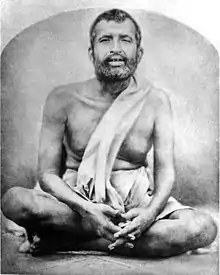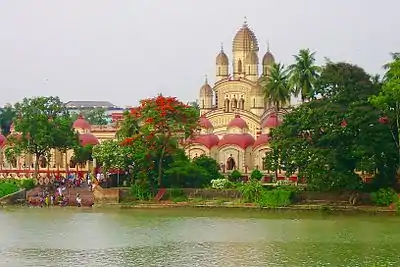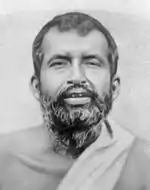Kalpataru Day
Kalpataru Day also called Kalpataru Diwas or Kalpataru Utsav is an annual religious festival observed by monks of the Ramakrishna Math monastic order of Hinduism and lay followers of the associated Ramakrishna Mission, as well as the worldwide Vedanta Societies. These organizations follow the teachings of Ramakrishna, the 19th century Indian mystic and figure in the Hindu Renaissance.


The event commemorates the day on 1 January 1886, when his followers believe that Ramakrishna revealed himself to be an Avatar, or God incarnate on earth. It is held each 1 January. Although the observances are held in many locations, the most significant celebration takes place at Cossipore Garden House or Udyanbati near Kolkata (then called Calcutta), present Ramakrishna Math, a branch of Ramakrishna Order, the place where Ramakrishna spent last days of his life. It is classified as one of the "Lord's special festivals" by followers of Ramakrishna.[1]
In India on 1 January 2010, as in other years, "Devotees from all over the country thronged the famed Kali Temple at Dakshineshwar for Kalpataru Utsav, which is celebrated on this day every year." [2] India's Eastern Railway scheduled two special trains on 1 January 2010, to carry the crowds to Kali Temple.[3] The event includes providing medical care, blankets and clothing to the poor.
Origins
The first Kalpataru Day, 1 January 1886, was "an event of unusual consequence and meaning" in the life of Ramakrishna and his followers.[4] Ramakrishna was suffering from throat cancer at that time, and his health was declining. He and his closest followers had moved to a garden house in the northern Calcutta neighbourhood of Cossipore. 1 January was a relatively good day for him, and he took a walk in the garden. There, he asked one of his followers, Girish, a question he had often asked before, "Who do you say that I am?" [4] Girish responded that he believed that Ramakrishna was "God incarnate, come to Earth out of mercy for humankind".[4] Ramakrishna replied, "What more shall I say? May you be awakened."[4] Ramakrishna then entered an "ecstatic state" and began touching all of his followers. Those he touched reported experiencing a variety of new states of consciousness, including vivid visions. For one, Vaikuntha, the visions persisted and interfered with daily life, so that he feared that he might be going insane.
One disciple, Ramachandra Dutta, explained that Ramakrishna had, in effect become Kalpataru (also called Kalpavriksha), the "wish-fulfilling tree" of Sanskrit literature and Hindu mythology.[4] Dutta named the commemoration of this mystical event "Kalpataru Day" as a result.[5] This event "carried meanings and memories of cosmic import for the disciples[4] and also prepared them for Ramakrishna's death",[4] which occurred only a few months later, on 16 August 1886.
None of Ramakrishna's monastic disciples were present during this event. Most having spent the night in meditation and keeping watch over the ailing Ramakrishna were taking rest, while others took the opportunity to clean Ramakrishna's room, bedding, etc. One of these disciples was Saratchandra Chakravarty, later known as Swami Saradananda. Having witnessed the day's event from the rooftop of Ramakrishna's residence, Saradananda later commented that "Kalpataru Day" is a misnomer, since the mythological wish-fulfilling tree (Kalpataru) grants anything, good or bad, and Ramakrishna gave only what was spiritually beneficial. Saradananda rather referred to the event as "the bestowal of freedom from fear on all devotees by revealing himself"
References
- Sri Ramakrishna, the Great Master. Swami Saradananda.
- "Kolkatans start new year with prayers and picnics". BombayNews.net Mumbai. 1 January 2010. Archived from the original on 4 October 2011. Retrieved 2 January 2011.
- "The City Diary 25-12-2009 - Special trains". The Telegraph. Calcutta, India. 25 December 2009. Retrieved 3 February 2020.
- Kripal, Jeffrey John (1998). Kālī's child: the mystical and the erotic in the life and teachings of Ramakrishna (2nd ed.). Chicago: University of Chicago Press. pp. 258–261. ISBN 978-0-226-45377-4.
- Balakrishnan, S. (31 December 2001). "The spiritual significance: On January 1, 1886, Ramakrishna Paramahamsa experienced divine bliss. That day is celebrated as "Kalpataru Day" by his followers". The Hindu. Chennai. Retrieved 3 January 2011.


